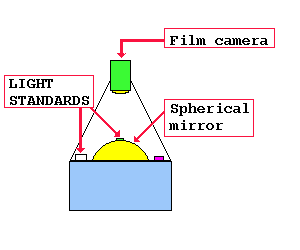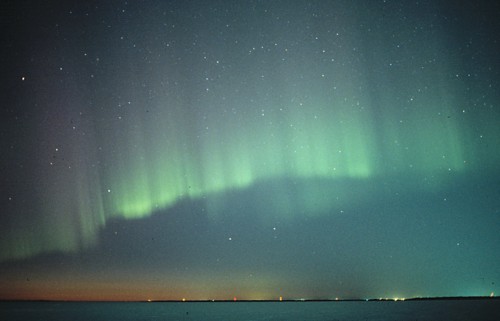Description of the old all-sky cameras
 The "old" all-sky cameras use a downward-looking film camera and a
spherical mirror to image the whole sky. There are also three light
standards and a small display that are imaged at the same time.
The "old" all-sky cameras use a downward-looking film camera and a
spherical mirror to image the whole sky. There are also three light
standards and a small display that are imaged at the same time. There are no filters, and the colours depend on the type of film that is used. The light standards have a known "colour" and can be used in calibrating the results.
Normally the camera takes one image
per minute, but it is possible to take images every 20 seconds
(for campaigns etc.). There are a couple of fixed exposure times;
mostly an exposure of two seconds is used and every tenth image is
exposed longer.
The operation of the imager is started and stopped manually, and after the film is full, one has to develop it before use. The films are the copied to video tapes (BetaCam) from which interesting events are digitised for computer use.
Technical specifications
| ITEM | DESCRIPTION |
| Camera | Baillard Bolex Type H 16 M-5 (16mm) |
| Camera objective | Angenieux B 25mm, 1:0.95 |
| Spherical mirror | Segment 208.5mm, r=140.0mm, f=690mm |
| Image intervals | 20s or 1, 2, 10, 20, or 60 minutes |
| Exposure times | 2, 4, 8 or 16s |
| Green light standard | FO4/G/300 (540nm) |
| White light standard | FO8/W/300 (560nm) |
| Red light standard | FO8/R/30 (608nm) |
More information: Kirsti Kauristie
e-mail: firstname.lastname@fmi.fi

